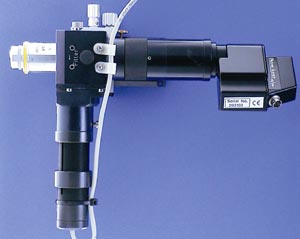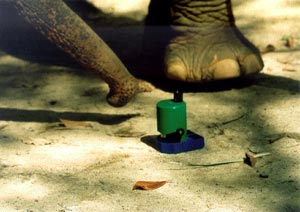|
|
| |
|
Fluorescence Microscope SpaceMike.
Made For Space For Use on Earth
Our first microscope design was for parabolic flights http://www.spaceflight.esa.int/users/file.cfm?filename=fac-pf-a300cin 1997

And was built for intracellular calcium experiments using the dye Oregon Green http://www.probes.com/handbook/sections/0105.html
On paradoxical thing about space experiments is that there is not a lot of space!
The take off and sometimes landings are very tough on the equipment!
Not a lot of power is available
Weight is severely limited
It is sometimes very difficult to manipulate the equipment.
Given all this we had to rethink the fluorescence microscope for the following specifications:-
- Tough
- battery powered
- small
- simple to use
- light
- no explosion risk (no high pressure lamps!)
- It must work reliably
This is the World’s first flourescence LED microscope

We used a Zeiss x10 objective that had for the magnification a very large numerical aperture (0.35) We could measure a few hundred cells in a field and looked at fluorescent intensity which is related directly to intracellular free calcium in this experiment:- nothing happened!.
However the microscope worked fine!
This microscope was specifically designed to be light, battery powered, compact and very rugged. We used a Blue 472nm LED from Nichia as the excitation source just 1mW.
We first used a Photonic Science extended ISIS intensified camera
http://www.photonic-science.co.uk/
then for extreme compactness a specially adapted intensified helmet camera also from Photonic Science which is shown in the figure.
We wanted to see how cells reacted to microgravity as many people equated forces of cells with their weight and assumed that cells could sense microgravity through the mechanosensor.
LEDs are perfect not only for space but Earth too. They are inexpensive, last for years, don’t use much energy (batteries!) are not sensitive to abuse and have good usable excitation wavelengths.
A few years ago in 1999 we competed for a German Space Agency DLR (www.dlr.de) First Chance programme to make this microscope available for you Earthlings and together with the space photometer we adapted the design for the products you see here, remaining compact, rugged and battery powered.
You see how the specifications for space are just those we need in certain places on Earth, such as in the field. Being also dust and waterproof it has great advantages! (www.dlr.de) First Chance programme to make this microscope available for you Earthlings and together with the space photometer we adapted the design for the products you see here, remaining compact, rugged and battery powered.
You see how the specifications for space are just those we need in certain places on Earth, such as in the field. Being also dust and waterproof it has great advantages!
Diagnostic Microscope.
The diagnostic microscope is designed to detect FITC and PE coupled antibodies. Targeting TB, Malaria and AIDS specifically as the BIG 3 but , with the right fluorescent dye coupled to the right antibody, any virus, bacteria or parasite can be detected. It uses a x 40 0.65NA achromatic semi plan objective.
It is water tight and unlike any other microscope it can be used anywhere!

Phi Phi Island Thailand
And is quite tough

We have other versions in test, with x 20, x 40 and x100 oil immersion and with cameras and built in colour intensified imaging chips
|
|
|